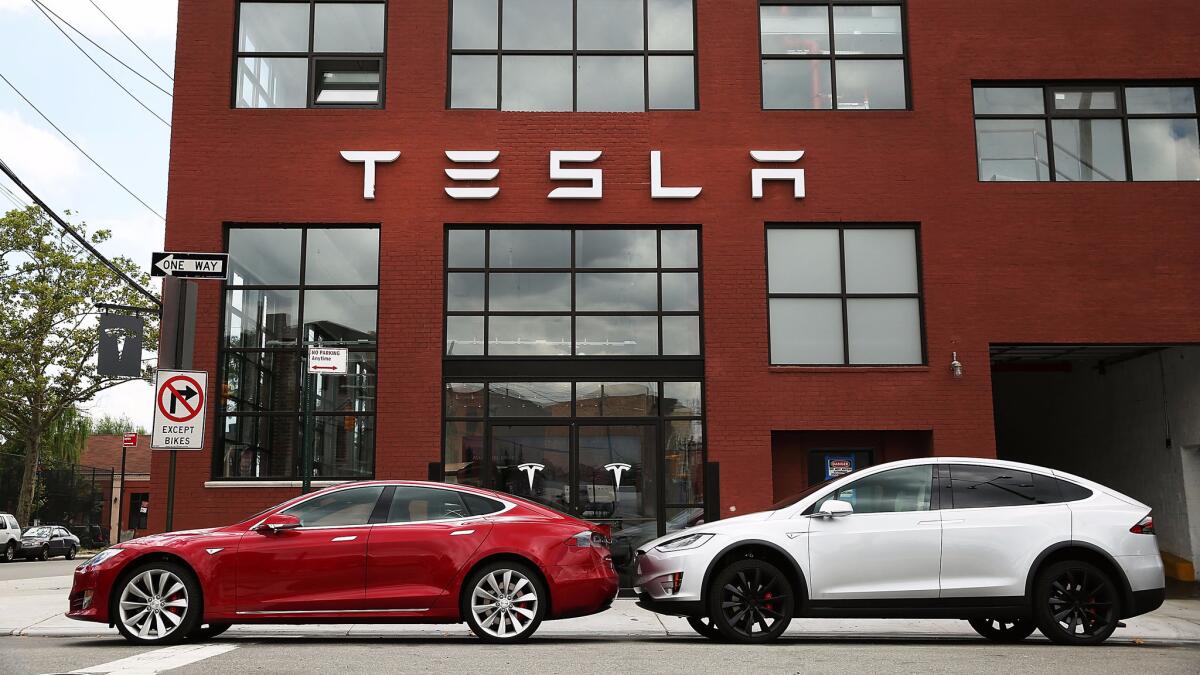Tesla says jealousy, not Autopilot safety concerns, caused breakup with Mobileye

- Share via
Tesla Motors and parts supplier Mobileye broke up in July. Now the two sides are dissing each other with wildly different takes on what caused the split.
Safety was the issue, according to Mobileye, which makes cameras and video processors for Tesla’s driver-assist system, called Autopilot.
Tesla was “pushing the envelope in terms of safety with Autopilot’s design, Mobileye Chairman Amnon Shashua told Reuters in a story published Wednesday. Autopilot is “not designed to cover all possible crash situations in a safe manner,” he said.
But Tesla says that wasn’t the reason for the companies’ split. A spokeswoman for the automaker told The Times on Thursday afternoon that the reason Mobileye was mad is because Tesla was developing a video-processing system of its own. When Mobileye found out, it “attempted to force Tesla to discontinue this development, pay them more, and use their products in future hardware,” the spokeswoman said.
When Tesla refused, she said, Mobileye “discontinued hardware support for future platforms and released public statements implying that this discontinuance was motivated by safety concerns.” At the time, Mobileye said it would end its relationship with Tesla when its current contract ran out.
Dan Galves, Mobileye’s chief communications officer, said Thursday evening that each company holds a different philosophy on safety.
“The reasons [Shashua] stated for the breakup are absolutely primarily the reason the relationship ended,” he said. “Were there commercial issues going on at the time? Yes, but those probably shouldn’t be discussed publicly.”
The July breakup came shortly after news that a Tesla Model S driver was killed in a crash in Florida this spring while using Autopilot. The sedan slammed into a big rig after Autopilot apparently failed to distinguish between the white truck and the bright sky behind it.
“No matter how you spin it, [Autopilot] is not designed for that,” Shashua told Reuters. “It is a driver-assistance system and not a driverless system.”
Tesla has repeatedly said drivers using Autopilot are warned to keep their hands on the steering wheel and be ready to take full control of the vehicle at any time.
After the two companies parted ways in July, Tesla Chief Executive Elon Musk said the split was “expected” and would “not have any material effect” on the electric automaker’s plans.
“Mobileye’s ability to evolve its technology is unfortunately negatively affected by having to support hundreds of models from legacy auto companies,” he said in a statement.
On Sunday, Tesla said it would upgrade Autopilot, and would beef up its radar systems to better augment the video system, even taking over for the camera in some situations. Musk also said the radar would become the “primary” sensor system on its automobiles, but a company insider told the Times Thursday that was not the word he would have used. “The camera and the radar will work together,” he said.
Tesla’s stock was up 1.98% to $200.30, at market close Thursday. Mobileye stock, down 9.7% since Monday, fell 0.35% to 39.68 on Thursday.
Bill Selesky, senior research analyst at Argus Research, said Shashua’s comments raise questions as to “whether this technology is ready for the public at this point.”
“Just the fact he came out with something, I think would be a negative for the company and ultimately the stock,” he said, though he later mentioned that Tesla’s stock often doesn’t react as expected.
Selesky said Shashua might be speaking out now, rather than in July when the partnership ended, because of the growing number of autonomous-vehicle developments from other automakers, such as Ford Motor Co. and General Motors. The comments could be seen as a warning to be careful, Selesky said.
Also this week, Tesla is facing new scrutiny in China about Autopilot after a state television broadcaster said a man killed in a fatal crash in January had activated the driver-assist feature.
The report by state broadcaster CCTV included apparent dash-cam footage of the car slamming into a slow-moving orange truck. The car’s driver, 23-year-old Gao Yaning, died in the crash.
An official interviewed in the report said the car’s Autopilot feature was active at the time of the crash. CCTV reported that Gao’s family has sued Tesla in a Beijing court, though the lawsuit was not available in online court records.
Tesla told the Associated Press that the car was too damaged in the wreck to transmit data to company servers and that Gao’s family had not cooperated with the company’s investigation.
Times staff writers Russ Mitchell and James F. Peltz and the Associated Press contributed to this report.
ALSO
Self-driving cars won’t always look this way
SpaceX faces a more crowded rocket launch market, even when it returns to flight
People want healthier food, so Cup Noodles is changing its recipe for the first time ever
UPDATES:
5:40 p.m. This article was updated with a comment from a Mobileye spokesman.
1:35 p.m.: This article was updated with remarks from a Tesla spokeswoman about the reason behind the split between Tesla and Mobileye.
10:20 a.m.: This article was updated with the current stock price and a comment from Elon Musk about Mobileye’s involvement with the Autopilot update.
This story was originally published at 9:20 a.m.





